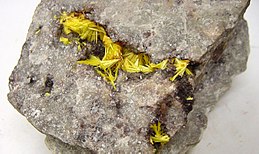Uranophane
| Uranophane | |
|---|---|
 | |
| General | |
| Category | Uranyl neso- and polysilicates |
| Formula (repeating unit) | Ca(UO2)2[HSiO4]2·5H2O |
| IMA symbol | Urp-α[1] |
| Strunz classification | 9.AK.15 |
| Crystal system | Monoclinic |
| Crystal class | Sphenoidal (2) (same H-M symbol) |
| Space group | P21 |
| Unit cell | a = 15.85 Å, b = 6.98 Å c = 6.64 Å; β = 97.45°; Z = 2 |
| Identification | |
| Formula mass | 586.36 g/mol |
| Color | Light yellow, lemon-yellow, honey-yellow, straw-yellow, green-yellow |
| Crystal habit | Crystals occur as stellate needle aggregates; as fibrous crusts, and massive |
| Cleavage | {100} Perfect |
| Fracture | Uneven |
| Tenacity | Brittle |
| Mohs scale hardness | 2.5 |
| Luster | Vitreous to pearly; waxy or dull when massive |
| Streak | Yellowish white |
| Diaphaneity | Translucent to subtranslucent |
| Specific gravity | 3.81–3.90 |
| Optical properties | Biaxial (−) |
| Refractive index | nα = 1.643 nβ = 1.666 nγ = 1.669 |
| Birefringence | δ = 0.026 |
| Pleochroism | Weak; X = colorless; Y = pale canary-yellow; Z = canary-yellow |
| 2V angle | 32° to 45°, measured |
| Ultraviolet fluorescence | Weak yellow-green under both short and long UV |
| Other characteristics | |
| References | [2][3][4] |
Uranophane (Ca(UO2)2(SiO3OH)2·5H2O), also known as uranotile, is a rare calcium uranium silicate hydrate mineral that forms from the oxidation of other uranium-bearing minerals. It has a yellow color and is radioactive.
Alice Mary Weeks, and Mary E. Thompson of the United States Geological Survey, identified uranophane in 1953.[5]
Classic samples have been produced at Madawaska Mine near Bancroft, Ontario.[6]
References
- ^ Warr, L.N. (2021). "IMA–CNMNC approved mineral symbols". Mineralogical Magazine. 85 (3): 291–320. Bibcode:2021MinM...85..291W. doi:10.1180/mgm.2021.43. S2CID 235729616.
- ^ Handbook of Mineralogy
- ^ Uranophane on Mindat.org
- ^ Uranophane on Webmineral
- ^ Moore, James Gregory (1963). Geology of the Mount Pinchot Quadrangle, Southern Sierra Nevada, California. U.S. Government Printing Office.
- ^ McDougall, Raymond (2019-09-03). "Mineral Highlights from the Bancroft Area, Ontario, Canada". Rocks & Minerals. 94 (5): 408–419. doi:10.1080/00357529.2019.1619134. ISSN 0035-7529. S2CID 201298402.
